B
| Battle of Harlaw Memorial Monument |
|---|
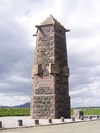
Erected in 1911 by the Burgh of Aberdeen a large polygonal tower shaped monument of coursed roughly dressed stone blocks with cornerstones in a contrasting redder stone. It has an outstepped base the angles of the main section are set with large square decorative bosses and it has a stepped top with protruding rainwater spouts. The lettering of the inscriptions in particular and the overall design in general has much of the 'arts and crafts' movement about it. More Information |
| Bennachie Story Wall Hanging |

A large textile wall hanging, celebrating the relationship of people and landscape, around Bennachie an outlier of the Grampian mountains that dominates the immediate area. One of its summits has a vitrified hill fort and it has been suggested as a possible location for the defeat of the Caledonians under Calgacus by Agricola's Roman troops at the battle of Mons Graupius. More Information |
| Bennachie typewriter sculpture |
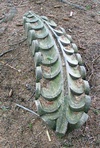
A sculpture composed of three carved wooden elements (spruce wood). Set under large conifers Making a visual pun between the letter keys of a qwerty keyboard and the seed cones of conifers. It comments on the commercial use of the trees to produce wood pulp for paper and the subsequent use of that paper. More Information |
| Bennachie, Totem Pole |

A wooden totem pole carved in the American Indian style near the Bennachie Centre, the main image being of an eagle with salmon on either side. Created by the Scottish Totem Pole Project a partnership between Royal Museum, the artist Kenny Grieve (Brotus Rural Crafts) and a group of Canadian First Nations carvers (on projects in 2002 led by XwaLackTun , Xwa works in two First Nation styles, the Northern Kwaguilth Coast Salish and West Coast Squamish). This cross cultural project involves schools and communities across Scotland investigating Northwest Coast artefacts, exploring their own heritage and natural environment, and creating uniquely Scottish totem poles.. see http://www.nms.ac.uk/totempoles/home/ More Information |
| Brandsbutt stone |

A class I Pictish symbol stone that may re-use a megalith from the stone circle that once stood here. 3 feet 6 inches high by 4 feet 2 inches wide by about 3 feet thick. It is re-assembled from fragments found in a dyke and some missing parts are substituted with cement. The south-east face bears the crescent and V rod and serpent and z rod symbols to the left of the symbols is an ogam inscription which reads IRATADDOARENS some part of which may be a version of the name Ethernan (as in St.Ethernan). |
| Broomend of Crichie |

A class I Pictish Symbol stone located in the remains of a class II henge monument (a henge is defined by having a bank and ditch class II henges are those with two opposed entrances). The symbol stone was originally located on a bank 50 yards to the north-east and was moved when this bank was utilised as ballast during the construction of the adjacent railway line. It was probably a Pictish reuse of one of the megaliths that formed the avenue and the other stone circle mentioned below. It bears a 'Pictish Beast' symbol over a crescent and V rod. More Information |
C
| Carved Stones, Fetternear House |
|---|

Photo 1:Carved sandstone, fragmented, set in the front of Fetternear House which was destroyed by fire in 1919. |
| Chapel of Garioch stained glass |

Chancel, window on theme of Sacrifice and Service; donated by Women's Guild, 1931. Shows the crucifixion with virgin and child above flanked by 2 Saints on either side. With smaller panels showing illustrations of biblical stories relevant to the theme. Text reads :"TO THE GLORY OF GOD AND IN MEMORY OF THE MEN AND WOMEN OF THIS CHURCH WHO LOVING THEIR LORD SERVED HIM IN LIFE AND DEATH." |
| Chapel of Garioch war memorial |
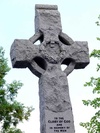
The Chapel of Garioch war memorial stands in the churchyard of the parish church. It commemorates the dead of both World War I & II. It is in the form of a Celtic crosshead of rough hewn granite in the centre of which is a carved wreath. The inscription and names for World War I are on the front of the memorial on a dressed surface. The base is formed of rough dressed boulders into the top of which is set a small block to commemorate the dead of World War II. More Information |
| Coldwells Sign |

A wonderful cut steel sign of a Clydesdale Horse in working harness, the harness detail suggests a working horseman's intimate knowledge, this plus the style and overall condition suggest it is of considerable age. More Information |
D
| Deer Park standing stones, or the Druids |
|---|

A setting of three stones, older reports describe a fourth fallen stone. Variously described as standing stones or the remains of a circle. It appears to have been too small to be a Recumbent Stone Circle. More Information |
| Dr Danny Gordons cairn and a memorial bench |

A small memorial cairn of mortared rubble inset with an oval panel of pink granite carved in relief with the words "Dr Danny Gordon's widdie" nearby is a bench presumably a memorial carved in relief with interlace and the words "WIGHT GLENLOGIE". More Information |
| Dunnideer, tower house and vitrified hill fort remains |

A dramatic hilltop ruin with stunning views over the surrounding countryside. More Information |
E
| Easter Aquhorthies RSC |
|---|

An impressive recumbent stone circle, 19.5 m in diameter, consisting of nine erect stones, the recumbent, two flankers and, in addition, two massive blocks which form a reserved area in front of the recumbent The circle is located near the crest of a hill shoulder, at 175 m OD. The characteristic differentiation between the recumbent with its flankers and the other circle stones can be seen vividly, both in terms of height of stones and their geological origin. The stones are graded in height from the 2.25 m tall flankers to the 1.7 m high stones on the circumference opposite, and, while the nine circle stones are of rough pinkish porphyry or (in the case of the second stone to the east of the flanker) a glowing red jasper, the flankers are of grey granite and the recumbent of reddish granite from near Bennachie. The outer face of the 3.8 m long recumbent has been smoothed carefully. The circle stones are set in a low bank. The very slight rise in the interior and a 1934 reference to a cist suggest the existence of a later ring cairn, now extremely vestigial. Its almost perfectly circular plan places this circle early in the series of recumbent stone circles More Information |
F
| Flying Visit |
|---|

Large welded metal sculptures of a 'Family' of Crows feeding outside a supermarket. Each is made from parts from former farm implements - ploughs, dividers, links, grubber wheels, bolts etc More Information |
| Fruits of Labour |

Carved from Indian Black Granite, a partial sphere with two larger hemispherical shapes suggestive of a sliced fruit, a peach for instance, each has a hemispherical void in its centre that matches the smaller sphere which is itself suggestive of the fruit stone. Contrast is provided by polished and unpolished surfaces. More Information |
G
| Golf View sculpture |
|---|
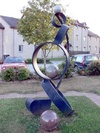
Metal and Granite, modernist sculpture with an iconography related to the game of golf. The sculpture is a reminder that the surrounding housing development is built on land that formed part of Inverurie old Golf Course. More Information |
| Grave Slab of Gilbert de Greenlaw |

Sandstone, the upright slab to Gilbert de Greenlaw, who was slain at the battle of Harlaw in 1411, stands in the kirk and exhibits a finely incised figure of a knight. The stone was obviously broken and reused, by a Forbes in 1592, with a Forbes incised armorial crest of three dogs and dated 1592 on the reverse side also inscribed with latin and greek texts. |
H
| Haughton Farm sign |
|---|
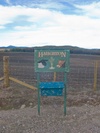
A painted sign in a folk art style with fine lettering reminiscent of fairground art, it shows a head of a bull and a sheep (probably intended as Limousin and Suffolk respectively), also a sheave of oats and three eggs indicating the farms enterprises. More Information |
I
| Inverurie 3 and 2 |
|---|

Inverurie 3 is the lower part of a Class I Pictish slab showing most of a double disc and z rod symbol and what may be the lower part of a disc symbol. Inverurie 2 is a very small fragment showing part of an ornately patterned mirror symbol. As well as Inverurie 4 (the famous Inverurie Horse), Inverurie 1 is located in the same place but is too worn to photograph well. More Information |
| Inverurie 4 |

A class I Pictish stone showing a horse the only occurrence of the horse in symbol form although hunting scenes with horses and riders are a frequent element of class II stones. As with all Pictish Symbol stones dating is somewhat contentious. As the stone is somewhat eroded a superimposed drawing is included to show detail. As well as Inverurie 3 and 2, Inverurie 1 is located in the same place but is too worn to photograph well. More Information |
| Inverurie War Memorial |
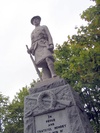
A war memorial of the figurative type with a life size statue of a soldier of a Highland regiment. It commemorates the dead from both World War I & II. It was unveiled on 20 September 1921. It has a tapering rectangular base of rough hewn granite with the name plaques of World War I set in the front and sides. Above the front plaque is carved a wreath behind which are a crossed rifle and sabre. Surmounting it is a statue of a kilted soldier in battledress with a rifle in his right hand resting on its butt. The memorial stands on a three-step base, the centre one of which has the names of the dead from World War II carved into three sides. |
J
| James Mitchell Memorial fountain, Kemnay |
|---|

In memory of James Mitchell (1773-1857), carrier, and to provide water for carters' horses, a late symphony in local granites, comprising a well and urn of pink granite with a square grey (Kemnay) granite arched superstructure bearing a sensitive pedestrian statue of Mitchell with roped pack, all in a railed hemicycle granite-walled enclosure with gate piers. |
K
| KEMNAY WAR MEMORIAL |
|---|
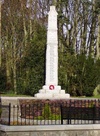
Its sides, back and three-step base are of rough hewn granite. The monument itself is a tall rectangular obelisk topped with a 'pitched-roof' shape from which projects a thin iron cross at right angles to the ground. Below this on the front are two carved panels, the upper of which has a Celtic cross in relief and below that a St Andrews cross within a shield shape. The memorial plaque to World War I is on the front while a side panel commemorates the dead of World War II. It was unveiled 24 September, 1922. More Information |
| Kinkell Kirk, Calvary Panel, replica |
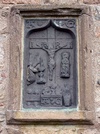
Bronze metal panel built into the north wall of Kinkell Church, showing the crucifixion, a figure of the Virgin Mary and an Angel. |
| Kintore 1 |
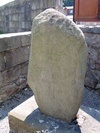
class I Pictish stone discovered underground in the churchyard (re used as a gravecover?). Now stands near the churchyard wall in a recess to the right of the entrance. |
| Kintore 4 |

A class I Pictish stone found in a garden in Kintore in 1974 at NJ790162 now in Inverurie museum it has a well executed Pictish beast and a rectangular symbol of which this is the only known occurence, also a plain mirror but no comb. More Information |
M
| Maiden Stone, Drumdurno |
|---|
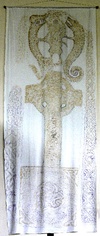
Class II relief carved pink granite Pictish Symbol Stone, 3 metres 20 cm x 86 cm x 25cm. The symbols being the notched rectangle and Z rod and the Pictish Beast (A.K.A. elephant, dolphin) with a mirror and comb qualifier. East face has 4 panels. The top one has various beasts and a Pict headed centaur, The second panel the notched rectangle and Z rod, the third the Pictish Beast and the bottom panel the mirror and comb. |
| Monymusk War Memorial |

Monymusk war memorial stands in the square in the village and commemorates the dead from both World War I & II. It is a tall tapering classical grey granite square-plan monolith with a flat top. It sits on a two-step base. A wreath is carved at the top of the front face. It was unveiled on November 21 1920. There is also one war grave in the nearby cemetery. More Information |
O
| Old Road, Bennachie Centre |
|---|
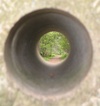
Carved words "THE TRAMPLING TO INVERURIE" and "THE TRUNDLING TO INSCH" on each side of a large granite stone next to the path just above the Bennachie Centre. In addition there is a hole drilled through the stone providing a sight line along the path. More Information |
P
| Percylieu Stone |
|---|
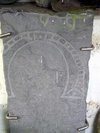
Pictish class 1 stone with part of a Salmon and Horseshoe symbols. More Information |
| Persephone |

Sculpted millstone grit figure of Persephone, the goddess of the underworld in Greek mythology (abducted by Hades and having to remain with him half of every year because she ate six pomegranate seeds the pomegranate can be seen in the statue's right hand), she is holding a mirror similar to that on the nearby Maiden Stone. |
| Picardy Stone, Myreton |

Class 1 Grey Whinstone Pictish Symbol Stone, 201cm x 102cm x 60cm. Three carved symbols on the south face, from top: Double Disc and Z-rod; Snake and Z-rod and a mirror. The stone stands on its original site, a low cairn, which is in a fenced enclosure, in front of the stone was a grave, this association makes this stone important to those who support the theory of symbol stones as memorials to dead individuals. More Information |
R
| Radulfus Slab, St Drostans Church, Insch |
|---|

The two medieval burial monuments have been placed against the outer face of the WNW gable. The first, which measures 1.05m in height, is the head and torso of the effigy of a knight dating to the late 13th- or early 14th century. It is heavily weathered, and the figure's face has sheered off, but traces of detail survive along its more sheltered sides; the figure is clad in mail armour, with a coif, a surcoat, a belt, and a large shield. Beside the effigy there is a grave-slab of red sandstone measuring 1.8m in length by 50mm in thickness and tapering in breadth from 0.43m to 0.34m. At its wider end a wedge-armed cross has been incised within a circle. Running along the slab is an incised inscription reading: ORATE:PRO:ANIMA:RADULFI:SACERDOTIS:. |
S
| Salmon Above The Flood , Don-Ury Ury-Don |
|---|

A Stainless Steel sculpture designed by Alison Simpson celebrating the town created on the confluence of the rivers Don and Ury. The salmon symbol evokes the Pictish symbol that is extant in sculptures still apparent in the local environment and thus the continuity of the settlement's cultural heritage. |
| Smithy Weathervane Dunnydeer |

A weathervane that combines the traditional cock with an anvil leaving no doubt about the trade conducted in the premises below. More Information |
| St Drostans Church Insch Bellcot |
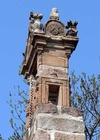
All that remains of the old kirk of Insch, said to be gifted to the Abbey of Lindores before 1195, is the W. gable complete with a stunning example of a 17th - century pedimented bellcote, in ornately carved red sandstone. The elaborate carving includes the letters M I L , The minister John Logie and the date 1613 |
| Sundial Castle Fraser |

17th-century sundial with complex lectern dial in freestone More Information |
T
| THE CALLING OF THE CUCKOO IS THE OTHER SIDE OF SPRING |
|---|

Made of various stones the work consists of the carved words "THE CALLING OF THE CUCKOO IS THE OTHER SIDE OF SPRING" on a low dyke. In addition there is a carved 'egg' with an incised crack. It celebrates the adjacent Goukstane ("Cuckoo stone"), which is signposted just off the walk to the summit, a large boulder. According to legend it is said to be visited by the first cuckoo to return to Bennachie after spending winter in Africa. Other people believe that this large stone was thrown down the hill by the mythical giant Jock O' Bennachie. |
| The Felling of the Timber, is the making of the home |
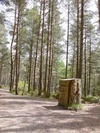
Tree stump carved in the shape of a cupboard with an open drawer and the words "THE FELLING OF THE TIMBER IS THE MAKING OF THE HOME" More Information |
| The folding of the land |
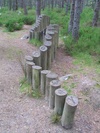
OS ref is approximate. A serpentine arrangement of lengths of round timber set upright in the ground. Each post is branded with a letter on the top so that the whole piece spells out the aphorism "The folding of the land is the unfolding of the way" More Information |
| The Gouk Stone, Bennachie |

The Goukstane ("Cuckoo stone"), which is signposted just off the walk to the summit. Is a large boulder. According to legend it is said to be visited by the first cuckoo to return to Bennachie after spending winter in Africa. Other people believe that this large stone was thrown down the hill by the mythical giant Jock O' Bennachie. |
| The Port Arch, Port Elphinstone |

The two arches of this bronze symbolise the bridges over the River Don and the Aberdeenshire Canal since it is because of these that Port Elphinstone (that part of the settlement on the South bank of the Don) came into being. The plinth section represents standing stones, The spaces between the three sections of the granite base represent the river and the canal. The symbols in the top surface were designed and executed together with children from Port Elphinstone school and represent episodes from the history of the town. More Information |
| The Wolf Stone |

Pictish Class 1 stone bearing the rectangle symbol sometimes described as a book case and a wolf, plus the mirror and comb symbol. More Information |
This content was submitted by external contributors and does not necessarily reflect the views of the University of Aberdeen.
